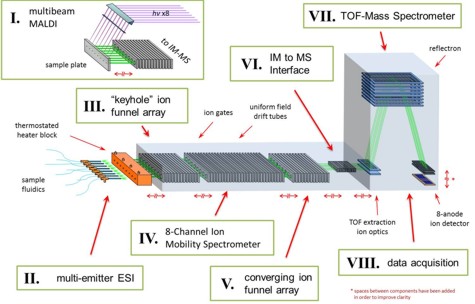Octoplex IM-MS (McLean Research Group)
PURPOSE
Spatial multiplexing strategies are common in sample preparation (96-well plates, microarrays and 2D gels) prior to MS analysis. Multiplexed pre-fractionation and sample delivery (multiple LC columns, arrayed electrosprays) have also been described. Parallel sampling improves statistical relevance and overall sample throughput, allowing more experiments with higher confidence results. As the front-end sampling is streamlined, the analyzer becomes the rate-limiting step. Operating several spectrometers in parallel is one solution, but this is oftentimes prohibitive in terms of monetary costs, maintenance investment and availability of laboratory space. One novel but challenging solution is to develop a multi-channel spectrometer in the footprint of a single-channel instrument.
DESIGN
We are developing an 8-channel ion mobility-mass spectrometer (8x IM-MS) based on an planar array design. The 8-channel design was chosen as a starting point because of the availability of 8-channel ion detection technologies and an 8x module can be scaled to higher multiples, such as a conceptual 96-channel IM-MS (12 modules) which could be used to analyze all samples of a 96-well plate simultaneously. Constructing a multi-channel instrument that utilizes a common vacuum system and electronics greatly simplifies costs and operational complexity. The ion mobility prototype shown here is housed in a vacuum system with a footprint of ca. 60x30x15 cm (LxWxH), however, this can be miniaturized to smaller than half this size with no compromise to the analysis.

